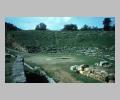
Overview of theater. Euboia, Eretria.

Overview of theater. Euboia, Eretria.

Behind the theater stage. Euboia, Eretria.

Temple of Apollo Daphnephoros. Euboia, Eretria.
| Summary: | One of the 4 major city states of Euboea. |
| Type: | Fortified city |
| Region: | Euboea |
Periods:
Geometric
Archaic
Classical
Hellenistic
Physical:
Eretria (the ancient city lies beneath the modern town) is located on the S edge of the Lelantine plain, on the W coast of Euboea, ca. 18 km S of Chalkis. The Classical city walls enclosed ca. 80 ha of flat ground between the harbor and the prominent acropolis to the N. The city, which was the most important in Euboea in the late 4th and early 3rd century B.C., was almost rectangular in shape, with the sanctuary of Apollo Daphnephoros at its center. The agora is between the Apollo temenos and the shore. Between the acropolis to the N and the Apollo temenos are the theater, stadium, gymnasium and other sanctuaries. Excavations at the West Gate (opening on the road to Chalkis) have located sections of the late Geometric walls and gate and a late Geometric heroon (hero shrine) beneath a later Hellenistic palace complex.
Description:
Eretria was listed in the Homeric Catalogue of Ships, but the location of the earliest city remains uncertain. The Mycenaean and Dark Age settlement at Lefkandi has been proposed as the site of "Old Eretria," but also as the site of "Old Chalkis." The earliest evidence for the situation of Eretria at its present location dates to the late Geometric period.
In the Geometric period, Eretria, along with Chalkis, led the cities of Greece in establishing colonies abroad. The maritime competition and possibly land disputes between Eretria and Chalkis may have caused the Lelantine War, one of the earliest reported conflicts between Greek city-states, which, according to tradition, continued throughout the 8th century B.C. One outcome of the war may have been the establishment of Eretria at its present location. The earliest remains at the city, including the West Gate Heroon, and sections of city walls and city streets (below the Classical levels) date to the 7th century B.C.
In ca. 500 B.C. Eretria contributed ships and aid to the Ionian Revolt. This resulted in the Persian retaliation in 490 B.C. which caused the destruction of Eretria and enslavement of many of the inhabitants. In 480 B.C. Eretria had recovered sufficiently to join the Greek forces for the defeat of the Persians. Eretria then became a member of the Delian League and remained allied to Athens until 411 B.C. In 411 B.C. Eretria joined (or perhaps led) the rest of Euboea in a Spartan inspired revolt from Athens. During the short-lived period of the Euboean League, the city of Eretria flourished. But by the early 4th century Eretria had reestablished good terms with Athens and during the rest of the century Eretrian political allegiance wavered between Athens and Thebes. By the end of the century Eretria was under the control of the Macedonians.
In 198 B.C. the city was plundered by the Romans and after this time no new building took place. In 87 B.C. it was finally destroyed in the Mithridatic wars and abandoned. The area reverted to and remained swamp land until a refugee settlement (Nea Psara) was located on the site in 1824 A.D.
Exploration:
Cyriacus of Ancona, the traveler, made drawings of sections of the city walls and the theater in 1436 A.D. Excavations: C. Tsountas, 1886; C. Waldstein and the American School, 1891-1895 (theater, temple of Dionysos, 2 gymnasia, and parts of city wall); K. Kourounotis between 1897 and 1917 (temple of Apollo and Archaic West gate); N. Papadakis, 1915; I. Konstantinou, 1952-1956; and since 1964 joint excavations by the Greek Archaeological Service and the Swiss Archaeological School.
Sources Used:
Other Bibliography:

